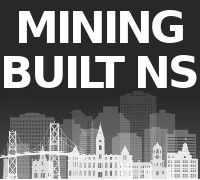- Why Mining Matters
- Jobs
- Safety
- Environment & Operations
- FAQ
- Links
- Fun Stuff
You are here

Gallihar and Dimock
Mr. Death
The Guilty Grenos
James Mitchell
Hugh McAskill
Gold Grows Under Shrubs?
Unexploded Dynamite
Tangier’s John Murphy
Joe Howe Dimock
Chats with Pioneer Miners
Charles Annand
John Scott Williams
Nicholas Fitzgerald
Chief Lonecloud
Pistols and Gold Mines
James MacDonald’s Thefts
John Vaughn
Herbert Dixon and the Halifax Explosion
James Bishop
Neily's Scandals
Waverley in 1934
Discovery of Gold at Dufferin
Hurricane Island
Fletcher and Faribault
Jack Munroe
Mine Apprentice Project
Small Gold Districts
15 Mile Stream
Tributers
E. Percy Brown and the Brookfield Mine
Barachois
Nova Rich Mines
Shad Bay Treasure Hunt
Montague 1937 Accident
Father Lanigan’s “Prospect”
George V. Douglas
The Stewart Brothers
Goldboro
Moose River's Touquoy Mine
Camerons Mountain
Jim Campbells Barren
Stanburne's Puzzling Gold Mine
Pockwock
Beaverbank Lake
Banook Mining Company
Deep Gold Mining
Wellington
Arsenic and Gold
Dynamite
War of Words
King of the Klondike
Oliver Millett
Kempt Gold Mining Company
Carleton
The Memramcook Fiasco
Love and Gold in Oldham
Montague 1893 Disaster
Central Rawdon Consolidated Mines
Cochrane Hill
Amateurish Early Gold Mining
Sable Island Gold
The Sea Wolf
Trueman Hirschfield
Alexander Heatherington
Prospector Joe Cope
Killag Quicksand
George W. Stuart
Wellington
Billy Bell
Cooper Jim Mine
South Branch Stewiacke
Walter Prest
Lake Charlotte
Acadia Powder Mills Company
The Ovens Anticline
Moose River Anticline
Avon Mine Explosion
Montague
Waverley Claims Dispute
Avon River
Moose River Disaster
Mooseland Scam
New York and Nova Scotia Gold Mining Company
Rosario Siroy and the South Uniacke Gold District
Blockhouse
Killag Gold District
Miller Lake
Baron Franz von Ellershausen
Mooseland: Nova Scotia’s first Gold Discovery
United Goldfields of Nova Scotia
Pleasant River Barrens Gold District
Lochaber Gold Mining Company
Rawdon Gold Mines
MacLean Brook
Gold in Clayton Park?!
Forest Hill
Meguma vs. Placer Gold
Uniacke
Voglers Cove
Gold River
Moosehead
Goldenville
Westfield
Indian Path
Harrigan Cove
Centre Rawdon
Nova Scotia’s Gold Mining History
WWII Gold
Middle River Gold District
Early Gold Discoveries
Halifax 1867
Paris Exhibition 1867
Mining and Tourism
An Act relating to the Gold Fields
Molega Gold District
Brookfield Gold District
Gays River
Halifax Gold
Caribou Gold District
Renfrew Gold District
Oldham Gold District
Whiteburn Gold District
Country Harbour Mines
Waverley Gold District
Robert Henderson and Klondike Gold
George Mercer Dawson
Cow Bay Gold District
Lake Catcha Gold District
Wine Harbour Gold District
John Brehaut
Goldenville’s John Brehaut mysteriously disappeared in 1925, triggering a search for the young man. His story highlights how different modern mining is from the historical era.
Brehaut disappeared from his home on July 21, and search parties were quickly organized. The Evening Mail reported on July 23, “Search parties have been out all day today and the woods are being scoured in all directions in addition to the men of the mines at Goldenville. Captain Agapeyeff sent a squad of men from the Sonora Timber Company, as did also Murdoch McCutcheon, of Sonora. Search has ceased tonight but will be resumed tomorrow morning at daylight.”
As soon as he heard about his brother’s disappearance, Joseph Brehaut came home from Granville, New York, where he was a minister in a Baptist church: “The aged father is completely broken down and much sympathy is being extended to him, as well as to the Rev. Mr. Brehaut,” wrote the Evening Mail.
The search turned up no clues and the newspaper reported on July 27 ,“The whole neighbourhood is inter-sected by disused gold mines and it is surmised that the body may be in one of these.”
An August 6 article also referenced the many small, abandoned mines in the area: “It is now believed that young Brehaut slipped into one of the many abandoned pits that abound in that section, although a diligent search for the missing young man is still being carried on.”
The newspaper also wrote, “Early reports of the mysterious disappearance of Brehaut are now contradicted by his relatives. It was stated at the time that Brehaut had locked his father in the house but relatives of the young man say that Brehaut locked only his own room having been in the habit of doing this whenever he left the house. He had some valuable papers in his room.”
The article concluded, “People in Goldenville are at a loss to account for young Brehaut’s disappearance. He has always been highly respected in the neighbourhood.”
Months went by before Brehaut was found. A November article in the Morning Chronicle tells us that “Mac Hattie, a lad, whilst setting rabbit snares this afternoon at Goldenville, noticed a pair of boots protruding above the water in an old mining shaft…The remains were found about a quarter of a mile behind Mr. Brehaut’s home in ground that had repeatedly been searched over.”
Gold was discovered in what became the Goldenville Gold District, just west of Sherbrooke in the Municipality of the District of St. Mary's, in 1861. Goldenville went on to be the largest-producing historical gold district in Nova Scotia.
Nova Scotia’s first gold rush in the early 1960s featured mostly amateur prospectors, with no experience or expertise, prospecting claims that were too small to be worked effectively, with no money to invest in proper equipment.
Many abandoned farms, fisheries and forests in the hope of striking it rich in gold mining. They smashed gold-bearing quartz with hammers and tried to follow quartz veins at shallow depth. Many gave up and returned to their other professions, finding that despite all the excitement about the gold rush, gold mining usually did not pay off, especially for those with no scientific understanding of the work.
As a result of these amateurish efforts, many historical gold districts like Goldenville were left with numerous dangerous, shallow openings. For example, by 1872, the Oldham district, near Halifax airport, had 43,000 feet of open trenches and its whole surface was honeycombed with trenches, shafts and pits, few exceeding 60 feet in depth.
In the modern era these openings would be reclaimed for both safety and environmental reasons.
However, historical miners had no concept of taking care of the environment - society’s environmental awareness was still a century away – and they had little understanding of the importance of safety measures.
As a result, John Brehaut met his end by falling down an abandoned mine shaft in the dark. His story is still a cautionary tale for anyone walking around historical mining areas that were not properly reclaimed. Be careful and stay away from historical shafts.
Modern mining is completely different. It is a sophisticated, science-based activity that takes excellent care of the environment and safety.
Nova Scotia’s mining and quarrying industry is one of the safer industries in the province today. We have reduced our injury rate 90% since the Westray public inquiry report of 1997.
In the 1990s, Nova Scotia started doing environmental assessments and better-regulating industrial projects to protect the environment. For example, a mine’s environmental assessment often takes 3-5 years of baseline, feasibility and design studies and costs are routinely in the millions of dollars. It generates dozens of scientific studies and governments often ask for even more studies and data - proof of how stringently modern mining is regulated to protect the environment and how different standards are today from historical periods.
Also, before getting operating permits, modern mining companies must get government approval of reclamation plans and post reclamation bonds (money in escrow, basically) that ensure funds are available to properly take care of sites. This ensures that sites are left safe for future users.

















































































